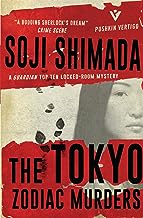Soji Shimada
Japan, 1936: The testament of excentric painter Heikichi Umezawa reveals his disturbing fascination with his own daughters. He describes his plan of killing all seven of them and to use the most beautiful body part of each to create Azoth – the perfect woman. Since Heikichi is dead, nobody is taking this seriously – until the Umezawa girls suddenly disappear and their mutilated bodies are found exactly where Heikichi had planned.
Japan, 1976: For 40 years, the nation has been obsessed with these so-called “Zodiac Murders”, but they are still unsolved. Then, amateur sleuth Kazumi Ishioka gets his astrologer friend Kiyoshi Mitarai onto the case. Together, they try to unravel the mystery and follow the leads where they take them – to an unexpected solution and one final death.
The first 24 pages of the book – Heikichi’s testament – are, quite frankly, terribly written, and I struggled to get through them. In hindsight, this was on purpose, though. Because once the story turned to the two amateur detectives, things did look up. It was interesting to watch them decipher the hints, even though the actual solution happens off the page, which I don’t particularly like. However, the final reveal of the by now aged killer and the motive came as a shock to me.
Twice towards the end of the novel, the author inserted himself with notes in which he challenges the reader: “All pieces are in place, can you solve the puzzle?” I didn’t care for that at all, but other people may enjoy this.
Soji Shimada was born in 1948 in Hiroshima prefecture. “The Tokyo Zodiac Murders” was his first book in 1981, and it was shortlisted for the Edogawa Rampo Award, a Japanese prize for crime fiction. Since then, Shimada has published numerous books and short stories, including the case books of the two sleuths on which this books focuses. In 2009, aged 61, he received the Japan Mystery Literature Award for his lifetime achievement.
If you’re in for a locked room mystery with a twist at the end, get this one from amazon.

